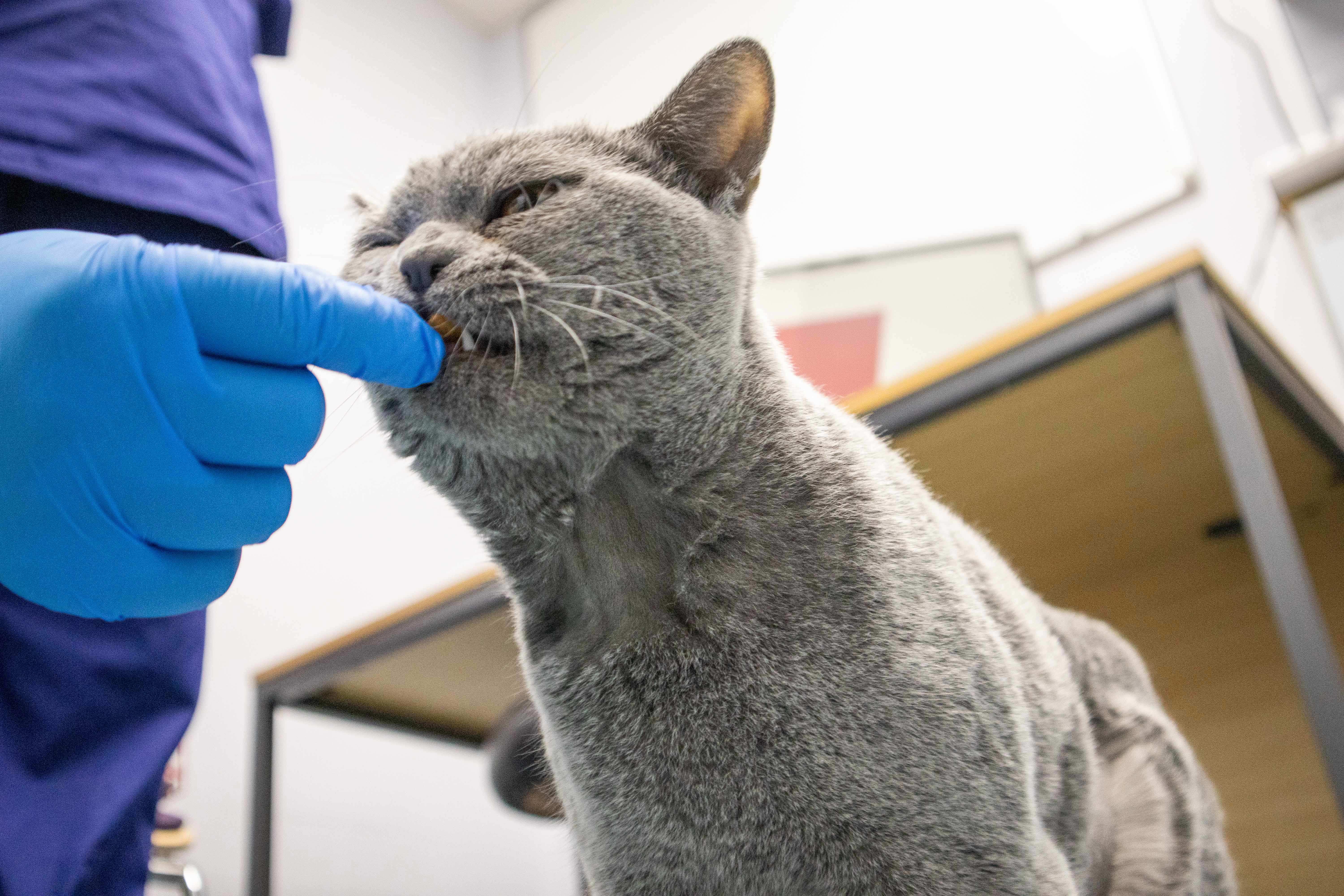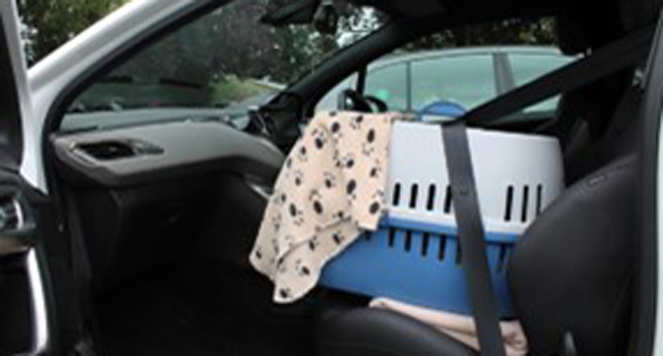Top tips for travelling with your cat to the Feline Centre
Which cat carrier should I choose?
The carrier should be large enough so that your cat can stand, stretch, and make a full turn. Hard carriers with a top-loading feature are a good option (shown below), as if your cat is unwilling to come out of the front of their carrier these make it easier for us to gently lift them out if necessary. Avoid carriers that only open from the front, as anxious or fearful cats that refuse to come out of their carrier may have to be pulled out or upended, which can be upsetting for your cat and it will also be much more difficult to get a reluctant cat back into the carrier this way.
How to get my cat in their carrier?
Cats are very sensitive to change and anything unfamiliar, therefore getting your cat accustomed to being in the carrier prior to your visit to the Feline Centre is key in reducing stress for your cat when travelling. Placing the carrier in an area of the home where your cat likes to spend his/her time, with familiar bedding, toys and treats placed inside will encourage your cat to use it. It may even be useful to remove the top half of the carrier initially until your cat becomes confident enough to venture into it.

Rewarding your cat with a tasty treat, fuss or their favourite toy when seen using the carrier at home will help create a positive association with their carrier.
Be patient. It may take days or weeks before your cat trusts the carrier, let them do this at their own pace and do not rush or place them into the carrier. Cats don’t like being forced to do anything and do not learn through punishment! If anything it will increase their suspicion of the carrier.
Carrying your cat gently around the house in the carrier for a very short period, then rewarding with a favourite toy or treat afterwards, can help create a positive association and get your cat accustomed to travelling within it.
If your cat needs to go to the vets, but is not yet comfortable with their carrier, try putting them and the carrier in a small room with few hiding places. Encourage your cat into the room and close the door. Use familiar bedding and offer a favourite treat or toy to try and entice your cat to enter the carrier on their own.
If your cat is not willing to enter the carrier, lowering your cat gently into a top-loading carrier is the best approach. Another option is to take off the top half of the carrier, so that you can place your cat into the bottom half, and then calmly replace the top half of the carrier to secure it. If your carrier only opens at the front, try ‘reversing’ your cat slowly into the carrier, tail end first. You can even try turning the carrier on one end with the door facing upwards, gently supporting your cat and holding the feet close to the body, lower him or her in tail end first.

Stay calm and move slowly; cats are very sensitive to our anxiety or frustration. Staying calm will help reduce their fear response and will make the process of placing your cat into their carrier much easier. If your cat panics at the sight of the carrier, keep it close by but out of sight, to avoid your cat becoming anxious at the thought of a possible trip to the vets as soon as they see the carrier. Keeping calm and quiet, place familiar bedding over your cat, or wrap your cat in the bedding (a towel or blanket will suffice), and gently place your cat and the towel into the basket swiftly.
International Cat Care have some fantastic cat carrier training videos online for further information
Spraying your cat’s carrier and bedding with a synthetic pheromone (Feliway™), at least 30 minutes before getting them into the carrier, can help cats to feel more secure. Feliway can be purchased from your vet or online.
We are also commonly now using gabapentin, an anxiolytic medication, for cats that are worried travelling or coming into the hospital. This is typically given 2-3 hours before putting a cat in their carrier. We recommend discussing this with your own vet, to check if this is suitable for your cat. In our experience we find this helps many cats and owners also tell us they feel less stressed too before setting off!
Travel within the carrier
Cats like things to be familiar and predictable and cars are obviously not a typical part of any cat's daily routine, therefore the car journey can be the most stressful aspect of bringing your cat to the Feline Centre.
Cats' aversion to car journeys is reinforced by the fact that, for many, the only time they go inside a vehicle is for a ‘dreaded’ vet visit. This creates a strong association between two potentially negative events, which may make each seem worse than it actually is. Some cats will never relax inside the car, but most can become accustomed to the car journey with a bit of practice. Try short journeys (just a few minutes trip around the block) at first and once tolerated, gradually increase the length of your excursions. Once you have increased the time spent in the carrier and the car, you may want to stop by the vets for a brief visit when there is not an appointment scheduled (this may not be convenient for your vet and so check with them first whether they can accommodate this type of ‘social’ visit). The goal is to associate cars, and trips to the veterinary clinic, with a positive
experience—catnip toys and treats are a wonderful way to assist with this. Cats tend to get motion sickness so avoid feeding your cat immediately before a car journey to reduce the risk of your cat becoming sick while travelling to the vets. Since your cat will be slightly hungry when they arrive, they will be more open to taking
treats from the staff here at the Feline Centre, making the visit pleasant for all involved.
Secure the carrier on the seat with a seatbelt or place it in the foot well of the car. Placing it on a towel can help to keep it level. Covering the carrier with a blanket or towel during the journey may help keep your cat calm.


Drive carefully to avoid your cat being thrown around within the carrier and keep the volume low on the radio.
Stay calm so that your cat doesn’t pick up any tension from you. Speak quietly and reassuringly during the journey. Take some spare, familiar bedding in case your cat is sick or soils in their carrier.
While it is true that some cats may never be perfectly content traveling long distances in their carrier or the car, following the tips above will go a long way towards reducing your cat's stress level and making trips to the veterinary clinic more pleasant for all.
Arrival at the Feline Centre
On arrival at the Feline Centre, try to avoid rushing. Keep your cat in their carrier and carry it carefully without swinging or banging it against your leg. Keep the carrier covered or place on a raised level (reception have a dedicated table for cat carrier parking while you book in, please help yourself to one of our blankets to cover your carrier on arrival if you haven’t brought your own, these are pre-treated with Feliway and will help to keep any other dogs and cats out of sight).
Our reception team will guide you to our feline only waiting room upstairs to wait for your consultation. Please let us know if your cat has had an accident or appears distressed and a member of our feline team will come to help you quickly.

We look forward to meeting you and your cat at the Feline Centre and hope these tips help ensure a minimally stressful journey for all involved.
Finally, we are proud to be a gold standard International Cat Care cat friendly clinic. We aim to make the entire visit pleasant and minimally stressful for you and your cat, please find information on the International Cat Care website that can tell you more about gold standard clinics.







